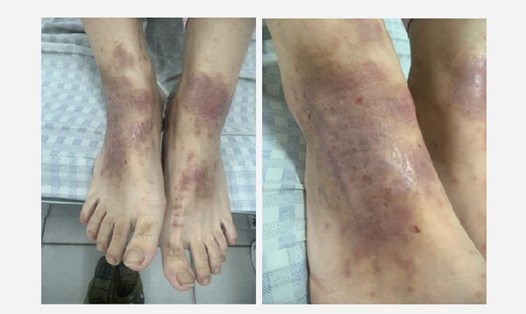Before being admitted to the Gastrointestinal Infectious Diseases Department, Clinical Institute of Infectious Diseases (108 Military Central Hospital), the patient had a pimple on the lower lip edge on the left cheek, accompanied by swelling, heat, and redness. The patient self-extracted the pimple and then developed a fever of 38 degrees, chills, and shivering. At home, the patient self-medicated with antipyretics, but it did not help. The family transferred the patient to the 108 Military Central Hospital in the following condition: High fever of 38 - 38.5 degrees Celsius, shivering, dry lips; the left cheek and lip area were swollen, discharging pus, limited mouth opening; mild shortness of breath, chest pain...
The patient underwent tests and was diagnosed with: Sepsis caused by Staphylococcus aureus entering from an abscess in the left face-chin area, with secondary infection of necrotizing pneumonia on both sides.
During the hospital stay, under the treatment regimen of the doctors and the dedicated and attentive care of the nurses, the patient's condition gradually stabilized, the swelling in the face-chin area significantly reduced, and body temperature returned to normal. The patient was discharged in stable condition.
According to Colonel, Dr. Nguyen Dang Manh - Director of the Clinical Institute of Infectious Diseases: Sepsis is a condition of systemic toxic infection caused by the invasion of bacteria and bacterial toxins into the blood. Sepsis often presents with many dangerous complications, especially septic shock, multiple organ failure, and a high mortality rate.
Pimples (commonly known as acne) are common skin lesions at all ages. Sebum, dead skin cells, and bacteria trapped in pores cause pimples, characterized by red, tender bumps with white pus at the tip. When a pimple forms, the pore swells and is under a lot of pressure. However, squeezing pimples can break the skin structure, causing more inflammation and infection, disrupting the local inflammatory cycle, and forming other pimples around.
Especially in the facial area, there is a region called the danger triangle, which can be identified by placing the hand so that the middle fingertip touches the nasal bone, and the palm covers the nose-mouth-chin area. This area has many veins connecting the nerves of the skull bones, helping to transport blood to the brain. Normally, veins have valves to prevent blood from flowing backward, but the veins in this area are valveless. Infections in the danger triangle can cause diseases such as sepsis, meningitis, facial muscle paralysis, nerve damage in the facial area causing facial muscle paralysis, and even death.








